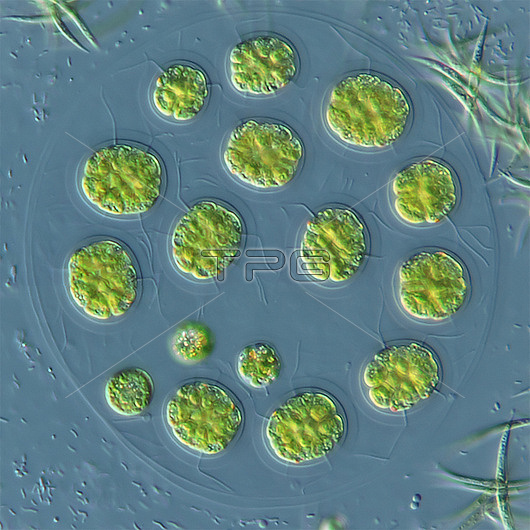
Colony of Chlorophyceae algae (Asterococcus superbus), light micrograph. Asterococcus is a green alga belonging to the order Chlamydomonadales, a group of unicellular algae. It lives in freshwater environments, where it can be planktonic (free-floating in the water column, as in ponds and lakes) or benthic (living attached to or on the bottom, as in bogs and marshes). This alga generally forms colonies made up of two cells, or a number equivalent to a power of two (4, 8, 16, sometimes up to 64 cells). These cells are grouped together inside a mucilaginous envelope (gelatinous substance), which is clearly visible under the microscope and often has a layered structure. Asterococcus cells are generally spherical or ellipsoidal in shape. Within the mucilaginous envelope, they may be either randomly distributed, or attached to the end of a branched peduncle also formed from mucilage. When these stalks branch out like the branches of a tree, it is known as a dendroid structure. Each cell measures between 10 and 40 micrometres in diameter. It has a smooth cell wall, a single nucleus, and usually two contractile vacuoles to regulate osmotic pressure. Inside the cell is a single chloroplast, located in the centre of the cell. This chloroplast contains a central pyrenoid, a structure involved in the synthesis and storage of starch. The chloroplast is also made up of numerous radiating lobes, which are flattened against the cell wall, increasing the surface area for capturing the light needed for photosynthesis. Magnification: x450 when printed at 10 centimetres wide.
| px | px | dpi | = | cm | x | cm | = | MB |
Details
Creative#:
TOP30268441
Source:
達志影像
Authorization Type:
RM
Release Information:
須由TPG 完整授權
Model Release:
N/A
Property Release:
N/A
Right to Privacy:
No
Same folder images:

 Loading
Loading